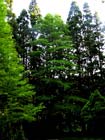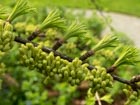
Tree in habitat, Wuyi Mountains, Fujian [Vladimir Dinets, 2006].

Cultivated tree, Pinetum Blijdenstein, Netherlands [C.J. Earle, 2010.06.11].

Cultivated tree, Kubota Gardens, Washington [C.J. Earle, 2018.04.29].

Foliage on cultivated tree, Pinetum Blijdenstein, Netherlands [C.J. Earle, 2010.06.11].

Immature pollen cones and emerging foliage on a cultivated tree, Kubota Gardens, Washington [C.J. Earle, 2018.04.29].

Bark on cultivated tree, Seattle WA [C.J. Earle, 2004.08.23].

Seedling amidst cone scales; Pinetum Blijdenstein, Netherlands [C.J. Earle, 2010.06.11].

Maturing seed cone [James Zhang, 2019.11.26, Facebook post].

Seed cone and foliage [James Zhang, 2019.11.26, Facebook post].

Harvested seeds with cone scales [James Zhang, 2019.11.26, Facebook post].

Seeds [James Zhang, 2019.11.26, Facebook post].

Conservation Status

Pseudolarix amabilis
(J. Nelson) Rehder 1919
Common names
Golden larch (Farjon 1990), 金钱松 jin qian song [Chinese] (Wu and Raven 1999).
Taxonomic notes
Syn. for the genus Pseudolarix: Laricopsis Kent 1900 non Fontaine 1889; Chrysolarix H.E. Moore 1965.
Syn for the sole species, Pseudolarix amabilis (Farjon 1998):
- Abies kaempferi Lindl. 1833;
- Pseudolarix kaempferi Gord. 1858;
- Larix amabilis J. Nelson 1866;
- Pseudolarix fortunei Mayr 1890;
- Laricopsis kaempferi (Lindl.) Kent 1900;
- Laricopsis fortunei (Mayr) Mayr 1906;
- Pseudolarix pourtetii Ferré 1944;
- Chrysolarix amabilis (J. Nelson) H.E. Moore 1965.
Description
Monoecious deciduous trees to 40 m tall and 150(-300) cm dbh, usually with a single trunk and a broadly-domed to irregular crown of long, spreading, horizontal to ascending branches. Overall, habit resembles Cedrus more than Larix. Bark gray-brown, rough, flaky, with age dividing into thick, square scales. Twigs include short and long shoots. Long shoots usually develop from 1-2 year old short shoots; leaves spirally arranged and radially spreading; initially reddish brown or reddish yellow, glossy, glabrous, becoming yellowish gray, brownish gray, or rarely purplish brown in 2nd or 3rd year, finally gray or dark gray. Short shoots develop from axillary buds on long shoots; leaves are radially arranged in false whorls of 10-30, often spirally spread like a discoid star. Most short shoots do not produce long shoots and instead grow 2-3 mm/yr, to a maximum length of about 3.5 cm. The winter buds ovoid, scales free at apex. Leaves are blue-green adaxially, pale green abaxially, slightly curved or straight, flexible, turning golden yellow before falling in autumn, narrowly oblanceolate-linear, flattened, 2-5.5 cm × 1.5-4 mm, slightly keeled adaxially, with stomatal lines abaxial in 2 bands separated by a midvein. There is 1 vascular bundle and 2-3(-7) marginal resin canals. Pollen cones terminal on short shoots in umbellate clusters of 10-25, becoming pendant at maturity. The pollen, shed in April, is 2-saccate, resembling Abies and Pinus pollen. Seed cones, which resemble those of Keteleeria, are green or purple-green, maturing reddish brown, obovoid or ovoid, 50-75 × 40-50 mm, solitary, erect, short-pedunculate, terminal on short shoots; they develop and mature in a single year, at the end of which (October) the rachis breaks up and the cone disintegrates (unlike Abies and Cedrus, which have a persistent rachis). The 18-30 seed scales are deltoid to ovate, thick, woody, wide-spreading, 28-35 × 17 mm, with a longitudinal, central, densely pubescent ridge adaxially, exposing the seedwing before maturity but not releasing the seed until the cone breaks up. Bract scales are ovate-lanceolate, 1/4-1/3 as long as seed scales, margin denticulate, adnate to seed scales at the base and shed together with them at maturity. Seeds white, ovoid, 6-7 mm, with resin vesicles on each side, with a light yellow or brownish yellow wing, glossy adaxially, triangular-lanceolate, circa 25 mm long, extending beyond the scale margin at maturity. Germination epigeal, producing 4-7 cotyledons. 2n = 44 (Farjon 1990, Wu and Raven 1999). See García Esteban et al. (2004) for a detailed characterization of the wood anatomy.
Distribution and Ecology
China: the native range is unclear but probably the lower Chang Jiang valley: N Fujian, Hunan, N Jiangxi, and N Zhejiang; it has long been cultivated in S Anhui, W Hubei, S Jiangsu, and E Sichuan. Found at elevations of 100-1000 m (to 1500 m on Jiuling Shan) in areas with a warm temperate climate and 1500-2000 mm annual precipitation, with no dry season. Occurs as a component of evergreen and deciduous broad-leaved mixed forests. Along the lower Chiang Jiang it is found with Acer spp., Carpinus spp., Catalpa ovata, Celtis spp., Quercus spp., Rhus spp., Juglans cathayensis, Nyssa sinensis, Ulmus spp., and other broadleaf trees. On Lu Shan in Jiangxi it is a canopy codominant in a seral (logged) forest with Pinus massoniana, P. tabulaeformis, Pterocarya spp., Platycarpa strobilacea and other species (Farjon 1990, Wu and Raven 1999).
Determining the native range of this and some other old Chinese trees (e.g. Ginkgo biloba) is problematic because old native forests were in some areas only preserved in the vicinity of Buddhist temples, yet at the same time ornamentals would be planted into these forests. Since this sort of thing has been going on for about a thousand years, it is often hard to tell if a tree established naturally or was planted. Notwithstanding, there are sites where the tree is definitely occurring due to natural regeneration (Farjon 1990). Its conservation status of "Vulnerable" but by now (2021) it is more likely to be "Endangered" based on the severity of threats it faces; the area of occupancy is small, the population is severely fragmented and there is continuing decline in the quality of the habitat and number of mature individuals. Habitat is being cleared for agricultural expansion (Yang and Christian 2013).
Hardy to Zone 6 (cold hardiness limit between -23.2°C and -17.8°C) (Bannister and Neuner 2001).
Remarkable Specimens
At least historically, trees in habitat were reported to 40 m tall and 150 cm dbh (Farjon 1990). Elwes and Henry (1906-1913) report that when the tree was documented by Fortune in 1854, he observed a tree 40 m (130 feet) tall and 77 cm dbh (8 feet girth). I have seen two fairly large trees in gardens, both about 70 years old, 15 m tall, and 40 cm dbh.
Ethnobotany
The wood has been used for furniture, boats, and bridges. It is most common, though, as an attractive ornamental tree with striking golden foliage in the fall (Wu and Raven 1999). It is particularly useful in warm humid climates where Larix will not thrive, and is also quite a popular species for bonsai (Examples).
Observations
Vladimir Dinets reports (email 2006.09.26) that it is easily located in the Wuyi Shan of Fujian, and in the Lushan of Jiangxi. Mixed mesophytic forests have been set aside as protected reserves on the Tienmu Shan and Lu Shan, and these include some of the most diverse temperate forests on earth. The Tienmu Shan forest includes 12 conifers species, and Ginkgo (Farjon 1990).
Remarks
The species was introduced to the western world via Robert Fortune's first visit to China in 1853 where he encountered massive trees 30-40 m tall and up to 150 cm dbh planted near the monastery of Can-cin in Zhejiang (Farjon 1990).
The genus name means "false larch"; although the foliage resembles that of Larix, the seed cone morphology clearly shows that it warrants treatment as a distinct genus. The epithet amabilis literally means "lovable" but in horticultural generally means "attractive."
Citations
Elwes and Henry 1906-1913 is at the Biodiversity Heritage Library (as P. fortunei). This series of volumes, privately printed, provides some of the most engaging descriptions of conifers ever published. Although they only treat species cultivated in the U.K. and Ireland, and the taxonomy is a bit dated, still these accounts are thorough, treating such topics as species description, range, varieties, exceptionally old or tall specimens, remarkable trees, and cultivation. Despite being over a century old, they are generally accurate, and are illustrated with some remarkable photographs and lithographs.
Farjon, Aljos. 1990. Pinaceae: drawings and descriptions of the genera Abies, Cedrus, Pseudolarix, Keteleeria, Nothotsuga, Tsuga, Cathaya, Pseudotsuga, Larix and Picea. Königstein: Koeltz Scientific Books.
Moore, H. E., Jr. 1965. Chrysolarix, a new name for the golden larch. Baileya 13(3): 131-134.
Rehder, A. 1919. New species, varieties and combinations from the Herbarium and the Collections of the Arnold Arboretum. Journal of the Arnold Arboretum 1:44-60 (p. 53). Available: Biodiversity Heritage Library, accessed 2021.12.19.
See also
Li, H.L. 1968. The Golden Larch, Pseudolarix amabilis. Morris Arboretum Bulletin 19(2):19-25.
Threatened Conifers of the World.











